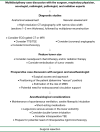Management of large mediastinal masses: surgical and anesthesiological considerations
- PMID: 27076967
- PMCID: PMC4805811
- DOI: 10.21037/jtd.2016.02.55
Management of large mediastinal masses: surgical and anesthesiological considerations
Abstract
Large mediastinal masses are rare, and encompass a wide variety of diseases. Regardless of the diagnosis, all large mediastinal masses may cause compression or invasion of vital structures, resulting in respiratory insufficiency or hemodynamic decompensation. Detailed preoperative preparation is a prerequisite for favorable surgical outcomes and should include preoperative multimodality imaging, with emphasis on vascular anatomy and invasive characteristics of the tumor. A multidisciplinary team should decide whether neoadjuvant therapy can be beneficial. Furthermore, the anesthesiologist has to evaluate the risk of intraoperative mediastinal mass syndrome (MMS). With adequate preoperative team planning, a safe anesthesiological and surgical strategy can be accomplished.
Keywords: Mediastinal neoplasms; diagnostic techniques and procedures; preoperative and perioperative care; thoracic surgery.
Conflict of interest statement
Figures

References
-
- Hsu AL. Critical airway obstruction by mediastinal masses in the intensive care unit. Anaesth Intensive Care 2013;41:543-8. - PubMed
Publication types
LinkOut - more resources
Full Text Sources
Other Literature Sources
